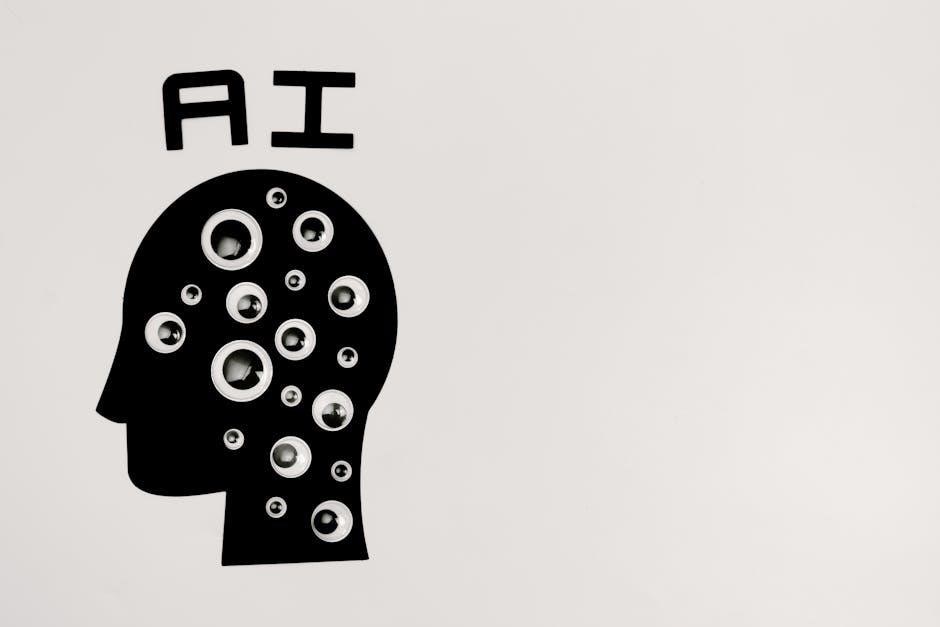
cognitive restructuring worksheet pdf
Cognitive restructuring is a powerful CBT technique that helps individuals identify and challenge negative thought patterns, promoting emotional well-being. Worksheets guide users in recognizing and transforming unhelpful thoughts, fostering mental clarity and resilience through evidence-based reflection and practical exercises.
1.1 What is Cognitive Restructuring?
Cognitive restructuring is a core cognitive-behavioral therapy (CBT) technique that focuses on identifying and challenging negative, unhelpful thought patterns; It involves examining the evidence for and against these thoughts, fostering a more balanced perspective. By restructuring these thoughts, individuals can reduce emotional distress and develop healthier ways of thinking. Often facilitated through structured worksheets, this process encourages self-reflection and practical exercises to transform unhelpful beliefs into constructive ones, promoting mental clarity and resilience.
1.2 Importance of Cognitive Restructuring in CBT
Cognitive restructuring is a cornerstone of CBT, empowering individuals to manage negative emotions by addressing their root cause—unhelpful thoughts. By challenging and modifying these thoughts, individuals can reduce emotional distress and develop coping strategies. Worksheets play a crucial role in this process, providing a structured framework for self-reflection and practical exercises. This technique not only alleviates symptoms of anxiety and depression but also enhances long-term mental resilience, making it a vital tool in psychotherapy and personal growth.
Key Components of a Cognitive Restructuring Worksheet
A cognitive restructuring worksheet typically includes sections for identifying automatic thoughts, emotions, and situational context. It also provides space for challenging unhelpful thoughts and exploring evidence for and against them, fostering a balanced perspective and promoting behavioral activation.
2.1 Identifying Automatic Thoughts
Identifying automatic thoughts is the first step in cognitive restructuring. These thoughts are immediate, often unconscious reactions to situations, frequently negative and unhelpful. Worksheets provide structured columns to document these thoughts, helping individuals become aware of their mental patterns. By recognizing these thoughts, users can begin to address and challenge them, fostering a clearer understanding of their emotional responses. This step is crucial for initiating the process of transforming unhelpful cognitions into more balanced and constructive ones, ultimately leading to improved emotional well-being and behavior.
2.2 Understanding Cognitive Distortions
Cognitive distortions are irrational thought patterns that distort reality, often leading to negative emotions. Common distortions include all-or-nothing thinking, overgeneralization, and catastrophizing. Worksheets help users identify these patterns by providing examples and exercises to recognize unhelpful thinking. By understanding these distortions, individuals can better challenge and reframe their thoughts, reducing emotional distress. This step is essential for developing more balanced and realistic ways of thinking, which is central to the cognitive restructuring process and overall mental well-being.

How Cognitive Restructuring Works
Cognitive restructuring works by identifying negative thoughts, challenging their validity, and replacing them with balanced, constructive ones. Worksheets guide users through this structured process, fostering mental clarity and emotional resilience through systematic reflection and practical exercises.
3.1 Step 1: Identifying Negative Thoughts
Identifying negative thoughts involves becoming aware of automatic, often unhelpful patterns that arise in response to situations. Worksheets guide users to describe the situation, list emotions, and document initial thoughts. This step encourages self-reflection, helping individuals recognize how their thoughts influence emotions and behaviors. By systematically capturing these thoughts, users gain clarity and prepare for the next steps of challenging and restructuring them constructively.
3.2 Step 2: Challenging Unhelpful Thoughts
Challenging unhelpful thoughts involves questioning their validity and exploring alternative perspectives. Worksheets prompt users to gather evidence for and against their thoughts, fostering objective evaluation. This step helps individuals identify cognitive distortions, such as all-or-nothing thinking or catastrophizing, and weaken their hold. By critically examining thoughts, users can reduce their intensity and develop a more balanced mindset, ultimately enhancing emotional regulation and problem-solving skills.
3.3 Step 3: Restructuring Thoughts
Restructuring thoughts involves replacing unhelpful ones with balanced, realistic alternatives. Worksheets guide users in crafting constructive thoughts by considering evidence and alternative perspectives. This step helps diminish negative emotions and fosters resilience. By reframing thoughts, individuals can adopt a more adaptive mindset, reducing distress and improving coping strategies. Regular practice enhances cognitive flexibility, enabling better emotional regulation and problem-solving in challenging situations.

Benefits of Using a Cognitive Restructuring Worksheet
Cognitive restructuring worksheets reduce negative emotions, promote behavioral activation, and enhance self-awareness. They help individuals understand their thoughts and emotions, fostering constructive actions and personal growth.
4.1 Reducing Negative Emotions
Cognitive restructuring worksheets effectively reduce negative emotions by helping individuals challenge and reframe unhelpful thoughts. By identifying distortions like all-or-nothing thinking, users can diminish feelings of anxiety and depression. These tools guide users to examine evidence for and against their thoughts, fostering a balanced perspective. Over time, this process leads to emotional regulation and a significant decrease in distressing emotions, promoting mental well-being.
4.2 Promoting Behavioral Activation
Cognitive restructuring worksheets promote behavioral activation by helping individuals recognize how their thoughts influence inaction. By challenging and restructuring these thoughts, users are motivated to engage in constructive actions, reducing avoidance behaviors. Worksheets provide a structured approach to identify and transform unhelpful thoughts into actionable steps. This process fosters a sense of control and encourages participation in activities that enhance mental well-being and overall quality of life.
4.3 Enhancing Self-Awareness
Cognitive restructuring worksheets enhance self-awareness by guiding users to reflect on their thoughts and emotions. Through structured exercises, individuals gain insight into their cognitive patterns, identifying distortions and exploring evidence for and against unhelpful beliefs. This heightened awareness fosters personal growth, enabling individuals to better understand themselves and develop a more balanced perspective, leading to improved emotional regulation and decision-making capabilities in various life situations.
Structure of a Cognitive Restructuring Worksheet
Cognitive restructuring worksheets typically include sections for situation description, emotion identification, and evidence for and against thoughts. These structured elements help users systematically challenge and reframe negative beliefs, promoting clearer thinking and emotional balance.
5.1 Situation Description
The situation description section requires individuals to provide a factual account of the event triggering their emotions. It focuses on objective details, avoiding interpretations or assumptions. Users are prompted to describe what happened, including the context and any relevant circumstances. This step helps in grounding the exercise in reality, making it easier to identify and challenge subsequent thoughts. For example, “I received feedback at work that my project needed improvements,” rather than “I failed the project.” This clarity sets the stage for effective cognitive restructuring. Worksheets often include examples to guide accurate descriptions, ensuring the process remains focused and productive.
5.2 Emotion Identification
Emotion identification involves recognizing and labeling the feelings experienced in a given situation. Worksheets often provide examples like “angry,” “upset,” or “scared” to help users accurately describe their emotions. This step encourages individuals to connect with their emotional responses, understanding their intensity and relevance to the situation. By acknowledging these feelings, users can better address the thoughts driving them, fostering a clearer path to cognitive restructuring and emotional regulation. This section is crucial for gaining insight into the emotional impact of specific events.
5.3 Evidence for and Against Thoughts
Evidence for and against thoughts involves critically examining the validity of negative beliefs. Worksheets guide users in listing supporting and contradicting evidence, helping to identify cognitive distortions. This process encourages a balanced perspective, reducing the intensity of negative emotions. By evaluating thoughts objectively, individuals can challenge unhelpful beliefs and develop more constructive ways of thinking. This step is essential for fostering rational thought patterns and emotional well-being.

Practical Applications of Cognitive Restructuring
Cognitive restructuring effectively manages anxiety and depression, overcomes cognitive distortions, and aids in relapse prevention through targeted exercises and evidence-based reflection.
6.1 Managing Anxiety and Depression
Cognitive restructuring is a valuable tool for managing anxiety and depression by addressing negative thought patterns. Worksheets guide individuals in identifying these thoughts, challenging their validity, and restructuring them into balanced perspectives. This process reduces negative emotions and fosters rational thinking, leading to improved emotional well-being and resilience against anxiety and depression.
6.2 Overcoming Cognitive Distortions
Cognitive restructuring helps individuals identify and challenge cognitive distortions, such as all-or-nothing thinking or catastrophizing. Worksheets guide users in listing distortions, analyzing evidence for and against thoughts, and reframing them into balanced perspectives. This process reduces emotional distress and enhances rational thinking. By addressing distortions, individuals can develop healthier thought patterns, leading to improved mental clarity and emotional resilience. Regular practice with cognitive restructuring worksheets fosters long-term cognitive change and personal growth;
6.3 Relapse Prevention Strategies
Cognitive restructuring worksheets play a vital role in relapse prevention by helping individuals identify triggers and challenge unhelpful thoughts. By documenting situations, emotions, and evidence for and against negative thoughts, users can better understand patterns that lead to relapse. These tools encourage proactive strategies, such as behavioral activation and mindful reflection, to maintain progress. Regular use of worksheets reinforces healthy thinking habits, reducing the likelihood of setbacks and promoting sustained emotional well-being. This structured approach empowers individuals to manage challenges effectively and maintain long-term mental health.

Additional Resources and Worksheets
Explore downloadable PDF worksheets, cognitive restructuring workbooks, and online communities for continued support. Resources like the Cognitive Skills Workbook and Relapse Prevention Worksheets offer structured guidance for lasting progress.
7.1 Recommended Cognitive Restructuring Workbooks
Several workbooks are highly recommended for cognitive restructuring, including “The Cognitive Skills Workbook” by CE Lawlor, which offers practical exercises and evidence-based strategies. Another excellent resource is the “Cognitive Restructuring Workbook,” designed to help individuals identify and challenge negative thought patterns. These workbooks provide structured guidance for understanding cognitive distortions, promoting behavioral activation, and enhancing self-awareness. Many are available as downloadable PDFs, making them accessible for self-paced learning. They serve as invaluable tools for therapists and individuals seeking to apply CBT techniques effectively in daily life.
7.2 Downloadable PDF Worksheets
Downloadable PDF worksheets are widely available for cognitive restructuring, offering structured exercises to identify and challenge negative thoughts. Resources like the “Cognitive Restructuring Worksheet” and “Thought Diary” provide columns to document situations, emotions, and evidence for or against thoughts. Worksheets from workbooks such as “The Cognitive Skills Workbook” can be accessed via links like https://osf.io/7ekz8/. These tools enable individuals to practice CBT techniques independently, fostering self-awareness and emotional regulation through guided reflection and practical applications.
7.3 Online Communities for Support
Online communities provide invaluable support for individuals practicing cognitive restructuring. Forums and groups dedicated to CBT and mental health offer shared experiences and advice. Members can discuss challenges, share progress, and learn from others using cognitive restructuring worksheets. These platforms foster accountability and motivation, helping users stay committed to their mental health journey. Additionally, many communities offer access to downloadable PDF resources, further enhancing the learning and application of cognitive restructuring techniques in a supportive environment.